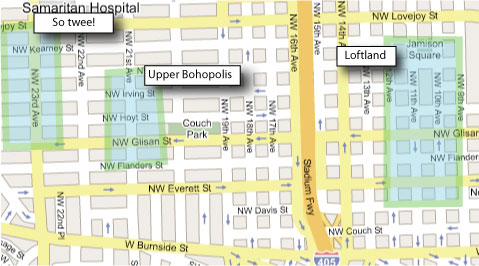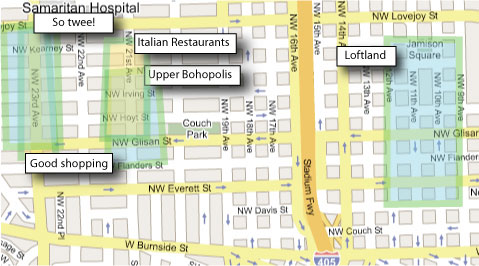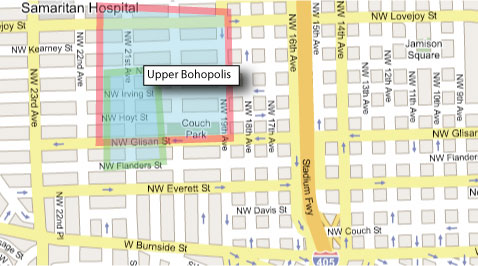In the last couple of months Liz and I have become friends with Jason and Di-Ann in Portland. They have a new startup called Platial. Platial is one of the sites in the cluster of social geographic bookmarking sites which are appearing (Tagzania and Plazes are two others, I think there are probably at least 6 more in the field). Its aim is to let you create a personal geography of interesting points. For example, I put in my childhood home and added a couple of tags. However, it's the only point I've put in, and I started to wonder why. For me, it's because none of these systems support one of the primary ways I think about personal geographies, which is in terms of regions.
For example, in addition to locating the specific place where Powell's books is located in NW Portland (where we live), I'd like to be able to identify regions of the place.

With this idea, people could add multiple tags to the same region...

Or different people could use the same tag with multiple regions, so that, like with other kinds of folksonomies, there wouldn't necessarily have to be agreement in the meaning of a term, but the variation would be informational in itself.

The general idea is that I think in terms of regions of activity, rather than clusters of points, when I'm thinking of personal geographies. If you look at the Google/Flickr memory maps you will notice this, too. Occasionally there are points or things that can be defined as points, but for the most part, it's areas.
[NB: "bohopolis" is my term for the fragmented bohemian city that I live in; whether it's the Mission District of San Francisco, Friedrichshain in Berlin, the Alberta Arts District in Portland, Corktown in Detroit, the East Village...it's all the same city, just unevenly distributed]




Oh just wait- there are unstopppable amounts of potentially addictive mapmaking tools- wanna help? Did you get the book Personal Geographies too? Between that and Atlass of experience, we're pretty inspired. We have actually begun this regionization through tag clusters on Places and maps. In the meantime, here's what I had to do to dub a new region (point by point) Portland's International District: http://platial.com/deisnor/map/1537#PDX_International_District
Points come first, then lines, then areas, then 3-d masses (buildings...), then moving items of any kind previously listed. I think our sites (if there's a chance) will evolve offering tagging of more complicated geographic objects.
In reverse: yeah, I have comment moderation turned on for anti-spam purposes. I should really make that clear on the homepage, it's been the subject of some confusion lately.
Please don't take my wish as a criticism. I think that Platial (and the other services) have a lot of potential and match the way that a lot of people think about the world. I was just thinking about my experience of all of the geographic markup sites and what was missing for me and I realized that it was regions. Yes, it would be great to mix the two, and I hadn't even thought of that. For me, geography is more a combination of overlapping plates (some more in focus than others, the ones that are closest to me being the smallest, the larger ones--like, say, "Nebraska"--being very large and very fuzzy), than a cluster of points, but I realize that's my own perspective.
do you have comment approval turned on or something? my previous comment just seemed to disappear into thin air, no feedback. hmm.
This mixing of points and regions would be great, you could search for 'tea house' in 'upper bohopolis'. The addition of regions and paths, both as objects, would surely be a big jump in the right direction of a generalized GIS for the people. We had to start somewhere though mike :)